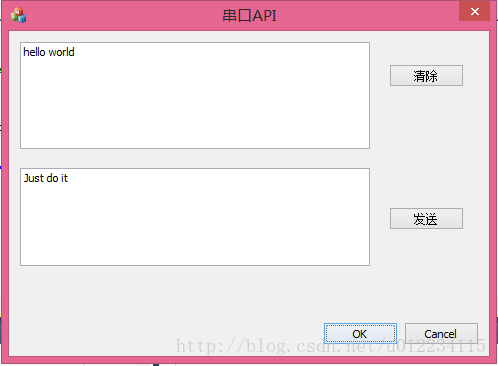VC++ API实现串口通信
【原文】http://dev.yesky.com/401/2308901.shtml
之前有篇博文讲过用ocx控件来写串口通信,但是那种方法不够好,每次把代码拷到其他电脑上还要重新注册一遍ocx插件,太繁琐,而win32 API的方式则方便的多,程序移植没有后顾之忧。
一、API描述
在WIN32 API中,串口使用文件方式进行访问,其操作的API基本上与文件操作的API一致。打开串口
Win32 中用于打开串口的API 函数为CreateFile,其原型为:
HANDLE CreateFile ( LPCTSTR lpFileName, //将要打开的串口逻辑名,如COM1 或COM2 DWORD dwAccess, //指定串口访问的类型,可以是读取、写入或两者并列 DWORD dwShareMode, //指定共享属性,由于串口不能共享,该参数必须置为0 LPSECURITY_ATTRIBUTES lpsa, //引用安全性属性结构,缺省值为NULL DWORD dwCreate, //创建标志,对串口操作该参数必须置为OPEN EXISTING DWORD dwAttrsAndFlags, //属性描述,用于指定该串口是否可进行异步操作, //FILE_FLAG_OVERLAPPED:可使用异步的I/O HANDLE hTemplateFile //指向模板文件的句柄,对串口而言该参数必须置为NULL );例如,以下程序用于以同步读写方式打开串口COM1:
HANDLE hCom;
DWORD dwError;
hCon = CreateFile("COM1", GENERIC_READ | GENERIC_WRITE, 0, NULL, OPEN_EXISTING, 0, NULL);
if (hCom == (HANDLE)0xFFFFFFFF)
{
dwError = GetLastError();
MessageBox(dwError);
}对于dwAttrsAndFlags参数及FILE_FLAG_OVERLAPPED标志的由来,可解释如下:Windows文件操作分为同步I/O和重叠I/O(Overlapped I/ O)两种方式,在同步I/O方式中,API会阻塞直到操作完成以后才能返回(在多线程方式中,虽然不会阻塞主线程,但是仍然会阻塞监听线程);而在重叠I/O方式中,API会立即返回,操作在后台进行,避免线程的阻塞。重叠I/O非常灵活,它也可以实现阻塞(例如我们可以设置一定要读取到一个数据才能进行到下一步操作)。如果进行I/O操作的API 在没有完成操作的情况下返回,我们可以通过调用GetOverLappedResult()函数阻塞到I/O操作完成后返回。
配置串口
配置串口是通过改变设备控制块DCB(Device Control Block) 的成员变量值来实现的,接收缓冲区和发送缓冲区的大小可通过SetupComm函数来设置。
DCB结构体定义为:
typedef struct _DCB { // dcb
DWORD DCBlength; // sizeof(DCB)
DWORD BaudRate; // current baud rate
DWORD fBinary: 1; // binary mode, no EOF check
DWORD fParity: 1; // enable parity checking
DWORD fOutxCtsFlow:1; // CTS output flow control
DWORD fOutxDsrFlow:1; // DSR output flow control
DWORD fDtrControl:2; // DTR flow control type
DWORD fDsrSensitivity:1; // DSR sensitivity
DWORD fTXContinueOnXoff:1; // XOFF continues Tx
DWORD fOutX: 1; // XON/XOFF out flow control
DWORD fInX: 1; // XON/XOFF in flow control
DWORD fErrorChar: 1; // enable error replacement
DWORD fNull: 1; // enable null stripping
DWORD fRtsControl:2; // RTS flow control
DWORD fAbortOnError:1; // abort reads/writes on error
DWORD fDummy2:17; // reserved
WORD wReserved; // not currently used
WORD XonLim; // transmit XON threshold
WORD XoffLim; // transmit XOFF threshold
BYTE ByteSize; // number of bits/byte, 4-8
BYTE Parity; // 0-4=no,odd,even,mark,space
BYTE StopBits; // 0,1,2 = 1, 1.5, 2
char XonChar; // Tx and Rx XON character
char XoffChar; // Tx and Rx XOFF character
char ErrorChar; // error replacement character
char EofChar; // end of input character
char EvtChar; // received event character
WORD wReserved1; // reserved; do not use
} DCB;
而SetupComm函数的原型则为:
BOOL SetupComm(
HANDLE hFile, // handle to communications device
DWORD dwInQueue, // size of input buffer
DWORD dwOutQueue // size of output buffer
);以下程序将串口设置为:波特率为9600,数据位数为7位,停止位为2 位,偶校验,接收缓冲区和发送缓冲区大小均为1024个字节,最后用PurgeComm函数终止所有的后台读写操作并清空接收缓冲区和发送缓冲区:
DCB dcb;
dcb.BaudRate = 115200; //波特率为115200
dcb.ByteSize = 8; //数据位数为8位
dcb.Parity = NOPARITY; //奇偶校验
dcb.StopBits = 1; //1个停止位
dcb.fBinary = TRUE;
dcb.fParity = TRUE;
if (!SetCommState(hCom, &dcb))
{
MessageBox("串口设置出错!");
}
SetupComm(hCom, 1024, 1024);
PurgeComm(hCom, PURCE_TXABORT | PURGE_RXABORT | PURGE_TXCLEAR | PURGE_RXCLEAR);超时设置
超时设置是通过改变COMMTIMEOUTS结构体的成员变量值来实现的,COMMTIMEOUTS的原型为:
typedef struct _COMMTIMEOUTS
{
DWORD ReadIntervalTimeout; //定义两个字符到达的最大时间间隔,单位:毫秒
//当读取完一个字符后,超过了ReadIntervalTimeout,仍未读取到下一个字符,就会
//发生超时
DWORD ReadTotalTimeoutMultiplier;
DWORD ReadTotalTimeoutConstant;
//其中各时间所满足的关系如下:
//ReadTotalTimeout = ReadTotalTimeOutMultiplier* BytesToRead + ReadTotalTimeoutConstant
DWORD WriteTotalTimeoutMultiplier;
DWORD WriteTotalTimeoutConstant;
} COMMTIMEOUTS, *LPCOMMTIMEOUTS;以下程序将串口读操作的超时设定为10 毫秒:
COMMTIMEOUTS to; memset(&to, 0, sizeof(to)); to.ReadIntervalTimeout = 10; SetCommTimeouts(hCom, &to);与SetCommTimeouts对应的GetCommTimeouts()函数的原型为:
BOOL GetCommTimeouts( HANDLE hFile, // handle of communications device LPCOMMTIMEOUTS lpCommTimeouts // pointer to comm time-out structure );事件设置
在读写串口之前,需要用SetCommMask ()函数设置事件掩模来监视指定通信端口上的事件,其原型为:
BOOL SetCommMask( HANDLE hFile, //标识通信端口的句柄 DWORD dwEvtMask //能够使能的通信事件 );有了Set当然还会有Get,与SetCommMask对应的GetCommMask()函数的原型为:
BOOL GetCommMask( HANDLE hFile, //标识通信端口的句柄 LPDWORD lpEvtMask // address of variable to get event mask );串口上可以发生的事件可以是如下事件列表中的一个或任意组合:EV_BREAK、EV_CTS、EV_DSR、EV_ERR、EV_RING、EV_RLSD、EV_RXCHAR、EV_RXFLAG、EV_TXEMPTY。
我们可以用WaitCommEvent()函数来等待串口上我们利用SetCommMask ()函数设置的事件:
BOOL WaitCommEvent( HANDLE hFile, //标识通信端口的句柄 LPDWORD lpEvtMask, // address of variable for event that occurred LPOVERLAPPED lpOverlapped, // address of overlapped structure );WaitCommEvent()函数一直阻塞,直到串口上发生我们用所SetCommMask ()函数设置的通信事件为止。一般而言,当WaitCommEvent()返回时,程序员可以由分析*lpEvtMask而获得发生事件的类别,再进行相应的处理。
读串口
对串口进行读取所用的函数和对文件进行读取所用的函数相同,读函数原型如下:
BOOL ReadFile( HANDLE hFile, // handle of file to read LPVOID lpBuffer, // pointer to buffer that receives data DWORD nNumberOfBytesToRead, // number of bytes to read LPDWORD lpNumberOfBytesRead, // pointer to number of bytes read LPOVERLAPPED lpOverlapped // pointer to structure for overlapped I/O );写串口
对串口进行写入所用的函数和对文件进行写入所用的函数相同,写函数原型如下:
BOOL WriteFile( HANDLE hFile, // handle to file to write to LPCVOID lpBuffer, // pointer to data to write to file DWORD nNumberOfBytesToWrite, // number of bytes to write LPDWORD lpNumberOfBytesWritten, // pointer to number of bytes written LPOVERLAPPED lpOverlapped // pointer to structure for overlapped I/O );关闭串口
利用API 函数实现串口通信时关闭串口非常简单,只需使用CreateFile 函数返回的句柄作为参数调用CloseHandle 即可:
BOOL CloseHandle( HANDLE hObject // handle to object to close );
二、例程
1,新建一个mfc对话框程序,在面板上添加两个编辑框,发送框关联字符串变量m_send,接收方关联变量m_receive,添加两个按钮,一个坐位发送,一个作为清除屏幕。
2,定义一个h文件和一个cpp文件,里面写串口的初始化,和创建线程监听函数。
SerialPort.h
#ifndef _SERIAL_PORT_CONTROL_H #define _SERIAL_PORT_CONTROL_H #define COM_RECVDATA WM_USER+0x001//自定义消息 extern HANDLE hCom; //全局变量,串口句柄 extern HANDLE hCommThread; //全局变量,串口线程 //串口监视线程控制函数 extern DWORD WINAPI SerialPort1ThreadProcess(HWND hWnd); //打开并设置PC串口1(COM1) extern BOOL OpenSerialPort1(); #endif
SerialPort.cpp
#include "StdAfx.h"
#include "SerialPort.h"
HANDLE hCom; //全局变量,串口句柄
HANDLE hCommThread; //全局变量,串口线程
BOOL OpenSerialPort() //初始化串口
{
//打开并设置COM1
hCom=CreateFile(L"COM3", GENERIC_READ|GENERIC_WRITE, 0,NULL , OPEN_EXISTING, 0, NULL); //COM3这里可以弄一个combobox选择
if (hCom==(HANDLE)-1)
{
AfxMessageBox(L"打开COM3失败");
return false;
}
else
{
COMMTIMEOUTS TimeOuts;
//设定读超时
TimeOuts.ReadIntervalTimeout=MAXDWORD;
TimeOuts.ReadTotalTimeoutMultiplier=0;
TimeOuts.ReadTotalTimeoutConstant=0;
//在读一次输入缓冲区的内容后读操作就立即返回,
//而不管是否读入了要求的字符。
//设定写超时
TimeOuts.WriteTotalTimeoutMultiplier=100;
TimeOuts.WriteTotalTimeoutConstant=500;
SetCommTimeouts(hCom,&TimeOuts); //设置超时
SetupComm(hCom,100,100); //输入缓冲区和输出缓冲区的大小都是1024
DCB wdcb;
GetCommState (hCom, &wdcb);
wdcb.BaudRate=115200;//波特率:9600,其他:不变
wdcb.ByteSize=8; //每个字节8位
wdcb.Parity=NOPARITY; //无停止位
SetCommState (hCom, &wdcb);
PurgeComm(hCom,PURGE_TXCLEAR|PURGE_RXCLEAR);
}
return true;
}
//以一个线程监控串口接收的数据
DWORD WINAPI SerialPort1ThreadProcess( HWND hWnd)//主窗口句柄
{
char str[101];
DWORD wCount; //读取的字节数
while(1)
{
ReadFile(hCom,str, 100, &wCount, NULL);
if(wCount > 0) //收到数据
{
str[wCount] = '\0';
::PostMessage(hWnd, COM_RECVDATA, (unsigned int) str, wCount);
//发送消息给对话框主窗口,以进行接收内容的显示
}
}
return TRUE;
}
3,在xxDlg类中添加自定义消息,afx_msg LRESULT OnRecvData(WPARAM wParam, LPARAM lParam); 消息ID写在SerialPort.h头文件里(因为在SerialPort.cpp里调用了) #define COM_RECVDATA WM_USER+0x001
在自定义的消息函数体种写接收数据代码LRESULT CPortDlg::OnRecvData(WPARAM wParam, LPARAM lParam)
{
CString recvStr((char *)wParam);
m_receive += recvStr;
UpdateData(false);
return TRUE;
}4,为发送按钮添加发送数据代码
void CPortDlg::OnBnClickedButton2()
{
// TODO: Add your control notification handler code here
UpdateData(true);
DWORD wCount = 0;
WriteFile(hCom, m_send, m_send.GetLength(), &wCount, NULL);//发送数据
}5,未清屏按钮添加代码
void CPortDlg::OnBnClickedButton1()
{
// TODO: Add your control notification handler code here
m_receive="";
UpdateData(false);
}6,给xxDlg添加系统消息WM_CLOSE,在程序退出时关闭串口连接,也可以专门弄一个按钮打开
void CPortDlg::OnClose()
{
// TODO: Add your message handler code here and/or call default
CloseHandle(hCom);
CDialogEx::OnClose();
}

注意:
- 发送和接收双方串口的波特率,奇偶校验,停止位要保持一致,且符合芯片硬件。
- 上面的程序有bug,接收正常,但是发送过去,对方只能收到第一个字母,搞了好久不知道问题在哪,还请哪位大神赐教一二啊!!